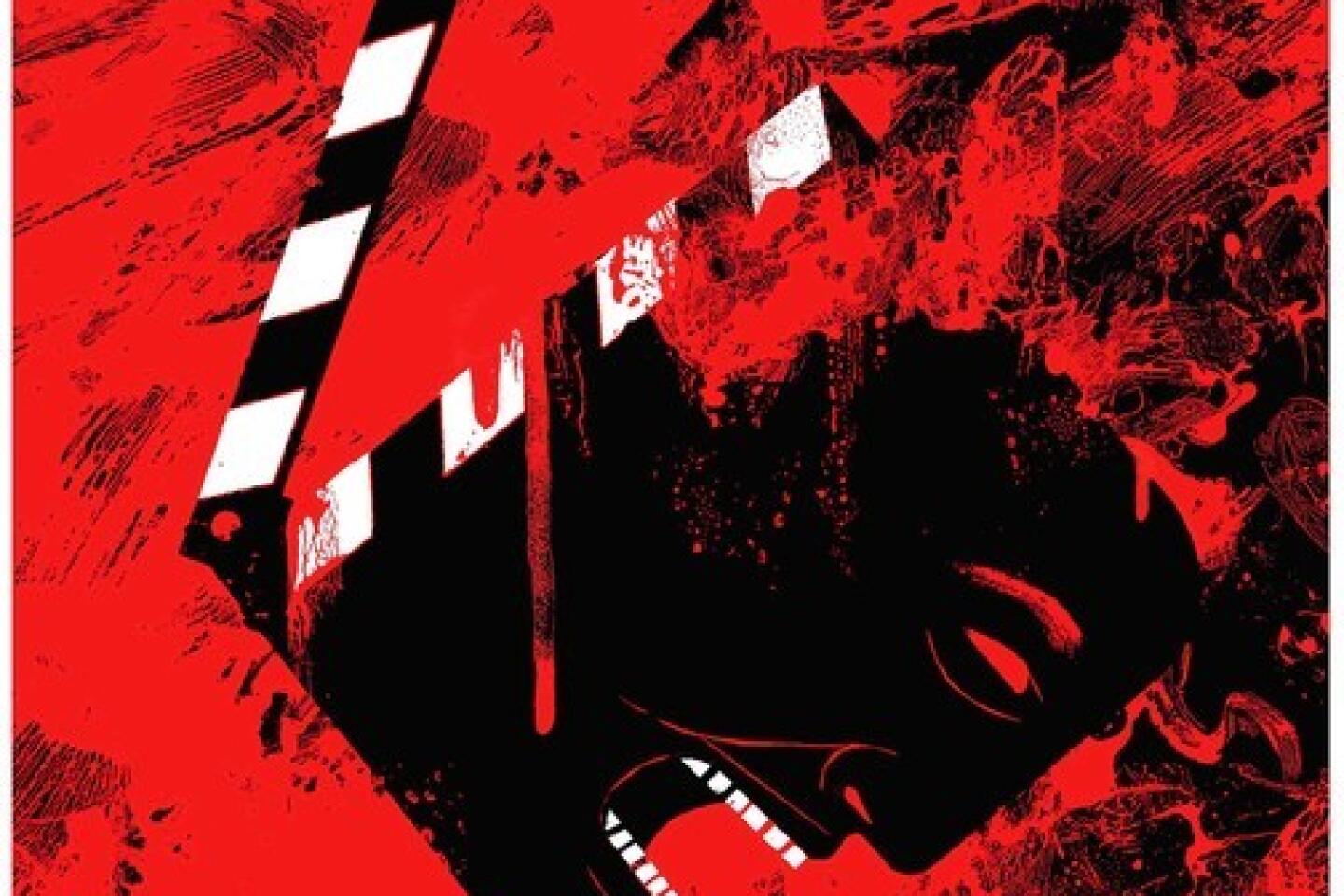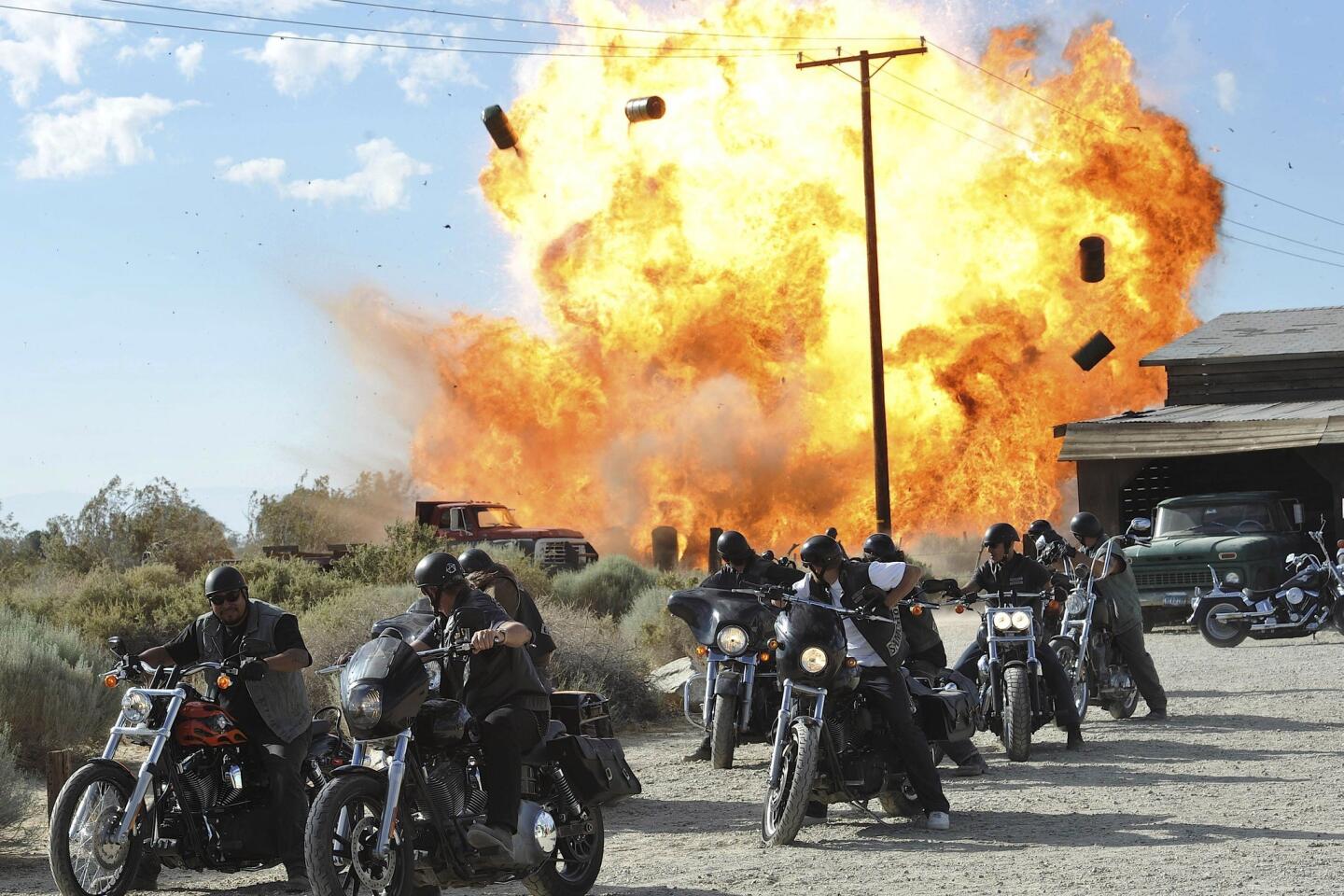Acceptable level of TV violence is ever shifting for viewers, execs
- Share via
To any viewer who thinks “Sons of Anarchy” is too violent, consider the bright side: At least the castration scene got … um … deleted.
Kurt Sutter, creator of the drama about a California motorcycle gang, presented the idea of showing a character getting the unkindest cut early in the run of the show, now FX’s highest-rated. But he backed off after the network’s chief objected.
“I have no filters,” Sutter said with a laugh. “I just assume everyone feels the way I do about things.”
THE CULTURE OF VIOLENCE: Art | Film | Television | Hollywood
In the wake of December’s Connecticut school shootings, TV violence has moved back into the policy debate. The head of the National Rifle Assn. controversially attacked the entertainment industry — including music videos and video games — for portraying “murder as a way of life.”
The Federal Communications Commission, which regulates the broadcast networks, has rules meant to curb language and sex on TV, but despite the persistent debate over real-life violence, it has no specific prohibitions on media violence. So the networks attempt to govern themselves through so-called standards and practices departments that read every script and watch every episode on the lookout for violence as well as sex and language deemed excessive. The departments typically have around 10 full-time staffers, many of whom are lawyers or have legal training.
Networks have long preferred to keep the process shrouded in mystery, perhaps to avoid laying down public precedents that could then be challenged. None of the four major broadcasters would allow a standards and practices official to talk on the record for this article, although some executives did not want to speak on the record.
THE CULTURE OF VIOLENCE: Video Games | World Cinema
While some show runners complain that the rules are arbitrary and amorphous, some critics argue that the “S and P” units aren’t doing their jobs at all. Some of the most popular series on TV right now are also among the most violent, including AMC’s “The Walking Dead,” Showtime’s “Dexter,” CBS’ “Criminal Minds” and Fox’s new hit “The Following.” ABC’s terrorism thriller “Scandal” recently drew criticism with a lengthy torture scene. Network chiefs were put on the defensive last month as reporters asked about the many serial-killer shows slashing their way through prime time, including an upcoming NBC drama based on fictional murderer Hannibal Lecter.
Some networks seem to be more permissive than others. A recent study by the Parents Television Council, a lobbying group and frequent entertainment-industry critic, examined prime-time programming on all five broadcast networks for two weeks this year. Heavily dependent on crime hits such as “CSI: Crime Scene Investigation” and “NCIS,” CBS was deemed the most violent network, with 33 scenes with violent gunplay during the period. It was trailed by ABC (14), Fox (nine) and NBC (four). CW had no violent scenes during the period. The study did not look at FX and other cable networks, which are not regulated by the FCC and where the standards tend to be much more permissive.
“If you were to ask the average viewer on the street, I think they would be surprised to hear that networks still have standards and practices departments at all,” said Melissa Henson, the group’s director of communications and public education. “They have this reputation of coming down all the time, but they really don’t do much” to stem violence on TV.
But networks say they rely on viewers to tell them where the boundaries are — and in any case, no definitive evidence proves that violent depictions cause real-life violence. (Some studies, however, have suggested that TV violence can desensitize certain viewers, especially young children.)
“I don’t think you can make the leap of shows about serial killers causing the violence that we have in our country,” NBC Entertainment Chairman Bob Greenblatt recently said, in the kind of demurral typical in the industry. TV veterans like to point out that onstage violence far predates the invention of their medium.
THE CULTURE OF VIOLENCE: On-screen history | Theater | Research
Network executives say they are constantly weighing how much violence they can show — despite what some skeptics might think. That is especially true when a mass shooting such as the one at Sandy Hook Elementary casts an unwelcome spotlight on the subject. “This has come up repeatedly, usually once a decade or so,” said Tim Brooks, a TV historian and former research executive for Lifetime and USA cable networks.
But producers complain that the rules are always changing so it’s often hard to know where the boundaries are. “For me the frustration is that it’s so arbitrary, and it changes from season to season,” Sutter said.
Still, there are some lines. Neal Baer, the former show runner of NBC’s “Law & Order: SVU,” said CBS has a prohibition against showing a bullet entering the human body, although showing the aftermath of a shooting is fine. (CBS declined to comment.) NBC’s Hannibal Lecter series will reportedly follow a similar path: Lots of bodies, but not many killings shown.
CBS will air Baer’s next show, “Under the Dome,” an adaptation of the sci-fi novel by Stephen King about the social breakdown of a small town cut off from the outside world. The Sandy Hook shootings have made him think hard about how violence will be depicted, but Baer said he hasn’t changed anything because of the tragedy. “We’re thinking about the social ramifications and how do we present that in a compelling way,” he said.
THE CULTURE OF VIOLENCE: Art | Film | Television | Hollywood
Brooks said the networks’ S and P offices have wielded power since the early 1960s, after a public uproar over the now-forgotten series “Bus Stop.” Critics were outraged that the pop idol Fabian played a psychopathic serial killer, arguing that it presented the wrong image to teenagers. Congress responded with the “‘Bus Stop’ hearings” designed to stem TV violence. Spooked, the networks decided to regulate themselves and began pulling back on the gritty stuff.
But as any viewer today knows, violence has come back bigger than ever, especially as cable programming has exploded over the past decade. The antihero of “Dexter” dreams up ever-more-chilling ways to dispatch his bad-guy victims. Zombies munch on human flesh in “Walking Dead.” Even on CBS — the most-watched network and also the oldest-skewing — the “CSI” franchise is built around the up-close autopsies of crime victims.
Although viewers sometimes complain about violence, they tend to get more irked by raw language or sexuality. Often they rationalize violence as long as it’s familiar to a genre, such as horror, or has a moralistic message attached. Brooks recalls a focus group 20 years ago when he worked for USA Network. Some parents talked about how much they liked the show “Walker, Texas Ranger,” which featured Chuck Norris as a crime fighter who took out the bad guys with martial-arts moves.
When the moderator pointed out that research had determined “Walker” was one of the most violent shows on TV, the room fell silent. Then one woman piped up and said that might be true, but it was OK because Norris played a good guy who helped people in trouble.
Sutter said that principle applies even on “Sons of Anarchy,” where the boundaries between good and evil are much murkier than on “Walker.”Still, he is astonished by what he sees as hypocrisy over on-screen violence.
“I’m amazed sometimes at the level of violence we get away with on my show,” he said. “Yeah, it’s OK to watch a girl burn to death, but God forbid I show a piece of her nipple. The sex boundaries are much more delineated and adhered to than the violence.”
More to Read
The complete guide to home viewing
Get Screen Gab for everything about the TV shows and streaming movies everyone’s talking about.
You may occasionally receive promotional content from the Los Angeles Times.









